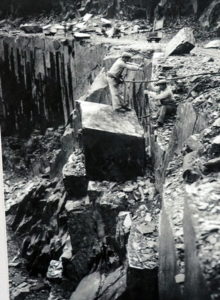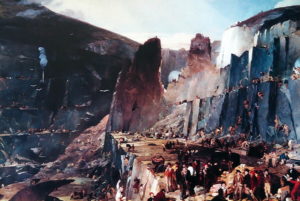This is one of a series of more detailed reviews for the “National Slate Museum.”:https://museum.wales/slate/
Inclines are a distinctive feature of the Welsh Quarrying industry and were used to carry slate from the quarries down the sides of the mountain to the workshops and railway below. The weight of the loaded slate wagons descending by gravity pulled up the empty wagons.
Large scale quarrying began at Dinorwic in the C19th and the remains for quarries and massive waste tips can still be seen as scars on the mountainsides. The Vivian Quarry can be seen as a tall series of open pits on the side of the hill above the museum and was named after WW Vivian who was one of the Dinorwic Company manages. It was worked until 1917 when it closed, only to be reopened in 1935 until finally being closed in 1960.
The slate veins slope downwards and the quarry was worked on the gallery system where slate was dug out from the surface as a huge pit up to 18’ deep. As the slate was removed, so new galleries were opened further up the hillside. The lowest galleries were left and gradually filled up with water.
Inclines connected the different levels. Each one had a small winding house with a big drum . Metal cables were connected to the wagons and a brake controlled the speed of the descending wagons.
All work was done by hand by men suspended by ropes setting gunpowder charges to blast out the slate which was then taken by wagons down the inclines to the workshops below.
The “lowest incline”:http://www.penmorfa.com/Slate/V2_incline_vivian_quarry.htm for the Vivian quarry was restored in 1998 and is the only incline of its kind in working order in the UK.
The incline has two tracks with a transfer table on each which are connected by a wire cable. Two loaded slate trucks are pushed along tramways on the quarry workings and onto the transfer table. The weight of the loaded transfer table pulls the empties back up. Once the transfer table with the loaded trucks has reached the bottom the wagons are pushed to the workshop and replaced by two empty wagons.
One of the rooms in the National Museum of slate has a lot of C19th photographs showing the quarry working.
There is a “trail”:http:// www.alltrails.com/explore/trail/wales/gwynedd/vivian-quarry-circular-walk?ref=sidebar-view-full-map taking walkers up through the different levels to the top of the quarry. If time allows this is a fascinating walk looking at the industrial archaeology of a once very important industry, with the remains of winding houses with their drums and brakes controlling downward speed on the wagons.









